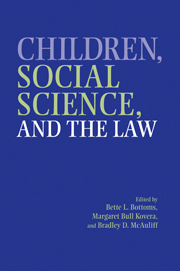Book contents
- Frontmatter
- Contents
- Acknowledgments
- Contributors
- 1 Children, Social Science, and the Law: An Introduction to the Issues
- PART I CHILDREN'S RIGHTS, THEIR CAPABILITIES, AND SOCIETY'S RESPONSIBILITIES TO CHILDREN
- PART II CHILDREN AND FAMILY CHANGE
- PART III JUVENILE AGGRESSION AND JUVENILE JUSTICE
- PART IV CHILDREN AS VICTIMS AND WITNESSES
- 12 The Effects of Community Violence on Children and Adolescents: Intervention and Social Policy
- 13 Preventing Child Abuse and Neglect
- 14 Children's Eyewitness Memory: True Disclosures and False Reports
- 15 Expert Testimony on the Suggestibility of Children: Does It Fit?
- 16 The Status of Evidentiary and Procedural Innovations in Child Abuse Proceedings
- PART V CONCLUSIONS AND FUTURE DIRECTIONS
- Author Index
- Case Index
- Subject Index
- References
12 - The Effects of Community Violence on Children and Adolescents: Intervention and Social Policy
Published online by Cambridge University Press: 24 July 2009
- Frontmatter
- Contents
- Acknowledgments
- Contributors
- 1 Children, Social Science, and the Law: An Introduction to the Issues
- PART I CHILDREN'S RIGHTS, THEIR CAPABILITIES, AND SOCIETY'S RESPONSIBILITIES TO CHILDREN
- PART II CHILDREN AND FAMILY CHANGE
- PART III JUVENILE AGGRESSION AND JUVENILE JUSTICE
- PART IV CHILDREN AS VICTIMS AND WITNESSES
- 12 The Effects of Community Violence on Children and Adolescents: Intervention and Social Policy
- 13 Preventing Child Abuse and Neglect
- 14 Children's Eyewitness Memory: True Disclosures and False Reports
- 15 Expert Testimony on the Suggestibility of Children: Does It Fit?
- 16 The Status of Evidentiary and Procedural Innovations in Child Abuse Proceedings
- PART V CONCLUSIONS AND FUTURE DIRECTIONS
- Author Index
- Case Index
- Subject Index
- References
Summary
The rate of community violence in the United States has increased dramatically over the past two decades (Osofsky, 1998; Parson, 1997). Although the numbers have begun to decline in recent years (e.g., in 1998, FBI crime statistics indicate that violent acts and property offenses dropped 7% nationwide [Morales & Reisner, 1999]), the rates remain high. For example, Saint Louis, Missouri, the city with the highest crime rate in 1998, had 14,952 crimes per 100,000 people. Miami, Florida, was ranked sixth in the nation in terms of crime, with 12,054 crimes per 100,000 people. The high rate of crime and violence in the country has had a profound impact on youth: The nation's young people, particularly those from low socioeconomic, multiethnic, and urban communities, are increasingly exposed to extreme acts of crime or violence, either as witnesses or as victims (Warner & Weist, 1996). As a consequence of this exposure, young people are at increased risk of experiencing myriad disturbing psychological symptoms.
One main set of problems that results in the aftermath of exposure to crime and violence is the development of distress symptoms, particularly those associated with posttraumatic stress reactions. Because of the high levels of distress experienced by youth who suffer from posttraumatic stress, it is important that interventions be developed that will help alleviate this distress. It also is important that social policy be formulated and implemented to curb young people's exposure to the trauma of community violence.
- Type
- Chapter
- Information
- Children, Social Science, and the Law , pp. 301 - 321Publisher: Cambridge University PressPrint publication year: 2002
References
- 5
- Cited by



